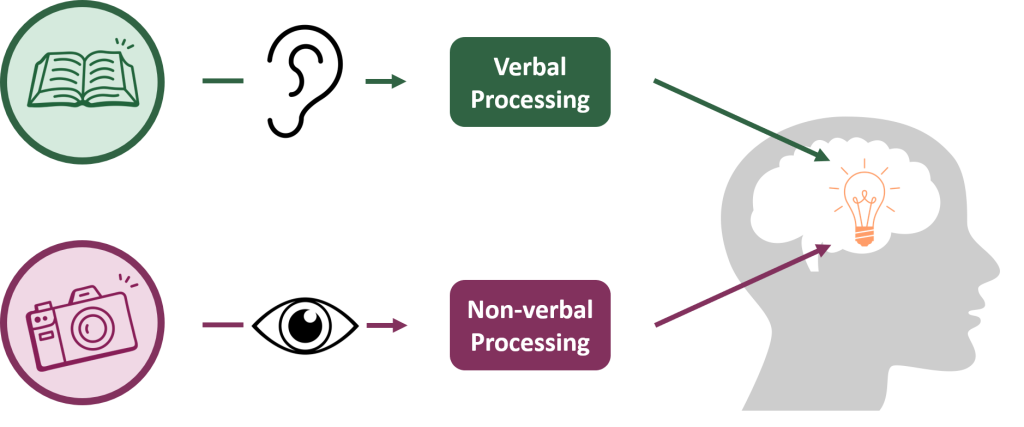Exploring Dual Coding

Exploring Dual Coding
Dual coding involves presenting information using both visual imagery and words. By presenting the same information in two modalities, students will benefit from two different ways to remember the information, and will make stronger connections with prior learning and knowledge.
Learning Outcomes
After completing this module, you will be able to:
- Explain the principle of dual coding
- Describe how dual coding improves learning
- Identify the barriers to using dual coding
- Demonstrate how to use interactive learning tools to support dual coding
Understanding Dual Coding
Dual-coding theory proposes that the brain processes visual and verbal information separately and simultaneously. When a concept is presented using both images and text or speech together, students encode both representations of the concept, resulting in more thorough processing and deeper retention of the information. People tend to remember images better than text, and so by incorporating images along with text, learners are more likely to recall the information as a result of having both visual and verbal cues.
The science of learning demonstrates that using multiple representations (e.g. images, text, and speech) of information creates multiple, connected memories for that information, resulting in more durable learning than if the student used only one representation.

Dual Coding – Video
The following two-and-a-half minute video is an introduction to dual coding. It explains what dual coding is and how this strategy supports student learning. Feel free to include this short video in your own courses to guide students as they explore effective learning techniques. You can find this video at the following link Tactic 5: Dual Coding Video
Here are some interesting and creative ways to use this video:
- Embed it in a task that asks students to share their dual coded notes for a specific course topic.
- Present it in class and explore with your students different methods they have used to engage in dual coding in their study notes.
- Build dual coding opportunities into note-taking templates and explicitly discuss how note-taking can be improved through the science of learning
Dual Coding – Infographic
You may want to share this infographic with your students to help them learn how to incorporate dual coding into their learning:
Attribution- Creative Commons-NonCommercial-NoDerivs by The Learning Scientists
Barriers to Dual Coding
In this section we explore some of the barriers that prevent students from engaging in dual coding. These can be used in a number of ways:
- to establish a reflective checklist for students to assist them in assessing their previous habits and methods of studying
- to support discussions about progress and next steps with students
- as a means of feedback to support students while they build their competency with learning
Resistance to Using Dual Coding
- Students may believe that they must be a good artist to use this strategy. Dual coding requires information to be clearly demonstrated but does not require artistic representation. Pictures can be anything and can be as simple or as detailed as required to meet the needs of the student.
- Some students will want notes and illustrations to be both beautiful and informative and may spend too much time making their notes pretty, taking away from needed study or review time.
- Some people may avoid dual coding because they do not know what visual tool to use.
Challenges Students May Face Using Dual Coding
- Dual coding can contribute to cognitive overload. Ensure that visuals support the concept being taught and provide time for students to process both the text and the visuals.
- Students may not select the correct type of image for the content (e.g. using a timeline to describe a biological process) which may impede their true understanding of the content/concept.
- Students may rush through or skim over the content, not taking time to reflect on the meaning of both the text and the image. Dual coding requires that both the text and the image are examined and purposefully reviewed.
- If the type of image used isn’t meaningful to the student it will not appropriately connect to the text or learning. Students may copy a classmate’s or instructor’s image, thinking that there is “correct” image to use. Students will form stronger connections and retain the information better if they self-select or draw their own visual representation of the content.
- Students may reject the use of images if they subscribe to the idea of learning styles and do not consider themselves a “visual learner” or feel their age or level of education is too advanced to use pictures in learning.
- Students may fail to organize the information to support sense making.
References
Photography on this page used with permission from the Durham College Online Photo Database.
Boser, U. (n.d.). Science of learning: Research meets practice – dual coding. The Learning Agency Lab. https://www.the-learning-agency-lab.com/learning-strategies/dual-coding/
Clark, J.M., & Paivio, A. (1991). Dual coding theory and education. Educational Psychology Review, 3(3), 149-210. https://doi.org/10.1007/BF01320076
The Learning Scientists. (n.d.). Dual coding. The Learning Scientists. https://www.learningscientists.org/dual-coding
Weinstein, Y., Madan, C.R. & Sumeracki, M.A. (2018). Teaching the science of learning. Cognitive Research: Principles and Implications, 3(2). https://doi.org/10.1186/s41235-017-0087-y
Weinstein Y., & Smith, M. (2016, September 1). Learn how to study using… dual coding. The Learning Scientists. https://www.learningscientists.org/blog/2016/9/1-1
© Durham College. All rights reserved.

